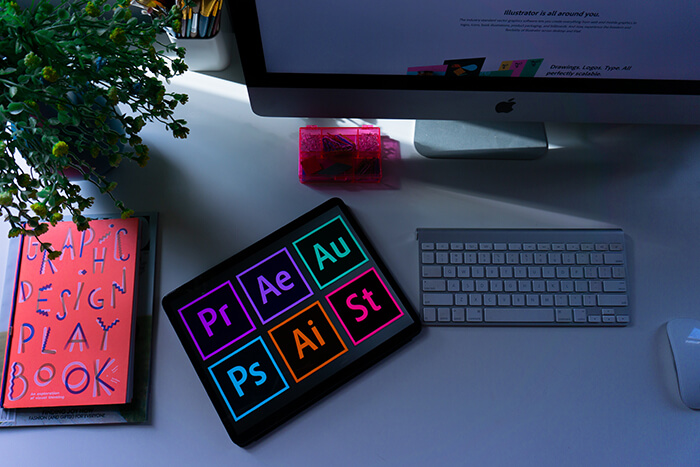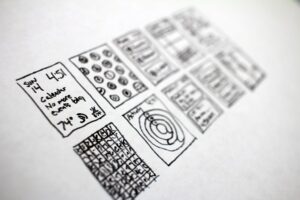As a graphic designer, your job is to communicate visually. This means creating designs that are both aesthetically pleasing and convey the message of your client. But with so much competition out there, how can you make sure your work stands out from the rest? In this article, we share 10 tips and tricks from professional graphic designers that will help you create better work!
1. Graphic design basics
There are some basic principles of graphic design that every designer should know. These principles include balance, contrast, hierarchy, and unity.
Balance is the distribution of visual elements on a page. Designers use balance to create a sense of stability and visual interest. Contrast is the use of different elements to create visual interest. Hierarchy is the use of size, color, and other elements to create a sense of importance. Unity is the use of all these elements to create a cohesive design.
If you want to become a successful graphic designer, it’s important to understand these basic principles. Once you understand them, you can start to experiment with different ways to use them in your own designs.
2. The importance of branding
1. Graphic designers need to be aware of the importance of branding. A strong brand can help a company to stand out from its competitors and build customer loyalty. A graphic designer should therefore understand the principles of branding and how to create a strong brand identity for a company.
2. It is also important for graphic designers to have a good understanding of marketing and advertising. This will allow them to create designs that are effective in promoting a company’s products or services.
3. In addition, graphic designers should be skilled in using various computer programs, such as Adobe Photoshop and Illustrator. This will allow them to create high-quality designs that meet the requirements of their clients.
3. Tips for creating attention-grabbing designs
1. Use strong, contrasting colors. This will help your design to stand out and grab attention.
2. Use interesting shapes and patterns. This will also help your design to stand out and be noticed.
3. Use a variety of different fonts. This will add interest and dimension to your design.
4. Be sure to proofread your work. This will ensure that your design is error-free and looks professional.
5. Take some time to experiment. This is the best way to find what works for you and your style.
4. How to use color in your designs
Color is one of the most important elements in graphic design. It can be used to create moods, convey messages, and draw attention to certain elements.
There are a few things to keep in mind when using color in your designs. First, you need to consider the meaning of different colors. For example, red is often associated with energy and excitement, while blue is associated with calm and serenity. You can use these associations to your advantage when choosing colors for your designs.
Second, you need to consider how different colors will work together. You don’t want to use too many different colors in one design, as this can be overwhelming. Instead, try to stick to a limited color palette. This will make your design more cohesive and easier on the eye.
Third, you need to be aware of the technical aspects of color. For example, you need to make sure that your colors print correctly if you’re designing for print media. You also need to consider colorblindness when choosing colors for your designs. Make sure that your color choices will be accessible to everyone who sees your design.
Overall, color is a powerful tool that you can use in your designs. Keep these tips in mind
5. Typography tips for designers
1. When choosing a font for your design, consider the tone you want to convey. For example, a more playful tone can be conveyed with a sans serif font, while a more serious tone might be better conveyed with a serif font.
2. Make sure the size of your text is legible and easy to read. A good rule of thumb is to use a font size that is around 10-12pt.
3. Use line spacing to make your text more readable. Line spacing is the space between each line of text. A good rule of thumb is to use 1.5x the font size for your line spacing. So, if you are using a 12pt font, your line spacing should be 18pt.
4. Use different fonts for different purposes. For example, you might use a sans serif font for body text and a serif font for headings or titles. This can help to create visual contrast and make your design more visually interesting.
5. Experiment with different fonts and combinations of fonts to find what works best for your design. There is no one perfect combination of fonts, so it’s important to experiment until you find something that looks good
6. The power of simplicity in graphic design
One of the most important things to remember in graphic design is the power of simplicity. Sometimes, less is more. A simple design can be more effective than a busy one. It can be easier for people to understand and it can be more visually appealing.
When you are designing, try to focus on the essentials. Don’t include anything that isn’t absolutely necessary. This will help to keep your design clean and clutter-free.
Another tip is to make sure that your elements are well-aligned. This creates a sense of order and can make your design look more professional. Pay attention to the details and take your time to create a polished final product.
7. Design trends for 2022
There are many different design trends that are popular in 2022. If you are a graphic designer, it is important to stay up-to-date on these trends so that you can create work that is relevant and appealing to your audience.
Some of the most popular design trends include minimalism, flat design, and bold colors. Minimalist designs are characterized by clean lines and a lack of clutter. Flat designs are two-dimensional and often utilize simple shapes. Bold colors are eye-catching and can be used to make a statement.
When choosing a design trend to follow, it is important to consider what your audience will respond to. Try to create work that is both visually appealing and on-trend.
8. How to stand out as a graphic designer
There are several things that graphic designers can do to stand out from the crowd. First, they need to have a strong portfolio that showcases their skills and talents. They should also be able to market themselves effectively and network with other professionals in the field. Additionally, they should stay up-to-date on the latest trends in graphic design.
Graphic designers who have a strong portfolio are more likely to get hired for jobs. Therefore, it is important for them to take the time to put together a portfolio that highlights their best work. They should also make sure to keep their portfolio updated with their latest projects.
In addition to having a strong portfolio, graphic designers need to be able to market themselves effectively. They should create a professional website and social media accounts that showcase their work. They should also make sure to network with other professionals in the field. By doing these things, they will be more likely to get hired for jobs.
Finally, graphic designers need to stay up-to-date on the latest trends in graphic design. They should read design blogs and magazines, and attend conferences and workshops. By staying up-to-date on the latest trends, they will be able to offer their clients the best
9. Networking tips for graphic designers
1. Get involved in the graphic design community. There are many ways to do this, such as joining a professional organization or attending conferences and workshops. This will help you meet other designers and learn about new trends and techniques.
2. Use social media to your advantage. Platforms like Twitter and LinkedIn can be great places to connect with other designers and showcase your work. Make sure to follow industry leaders and stay up-to-date on the latest news.
3. Stay active in online forums and groups. There are many online communities for graphic designers where you can share tips, advice, and feedback with others. This is a great way to learn from more experienced designers and make connections.
4. Start a blog or portfolio site. Having an online presence is essential for any graphic designer. A blog or portfolio site is a great way to showcase your work and attract potential clients or employers.
5. Don’t be afraid to network in person. Attend local meetups or events related to graphic design. This can be a great way to meet people in your area and get your name out there.
10. Graphic design software
There are a few different software programs that you can use for graphic design. The most popular ones are Adobe Photoshop and Illustrator. These programs are used by professional graphic designers all over the world. They are very powerful and have a lot of features that you can use to create amazing designs.
If you are just starting out in graphic design, it is important to choose a software program that is easy to use. Photoshop and Illustrator can be quite complicated, so it might be a good idea to start with a simpler program like Inkscape or GIMP. These programs are free to download and use, so you can try them out without spending any money.
Once you have chosen a software program, it is important to spend some time learning how to use it. There are plenty of tutorials and guides available online. You can also find books that teach you how to use the different features of the program. Once you have a good understanding of how the program works, you will be able to create stunning designs.
Conclusion
There you have it, 10 tips and tricks from some of the top graphic designers in the industry. By following these tips, you can up your own graphic design game and create stunning visuals that will wow your clients and help you stand out from the competition. So what are you waiting for? Get out there and start putting these tips to use!




